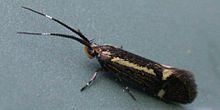
Hemaris thysbe, the hummingbird clearwing, is a moth of the family Sphingidae (hawkmoths). Coloration varies between individuals, but typically the moth is olive green and burgundy on its back, and white or yellow and burgundy on the underside. Its wings are transparent with a reddish-brown border. It has light-colored legs, which combined with the lack of striping on the underside is diagnostic. Beating its wings rapidly, H. thysbe hovers to collect nectar from a variety of flowers. The combination of its appearance and its behavior commonly leads to it being confused with a hummingbird or bumblebee.
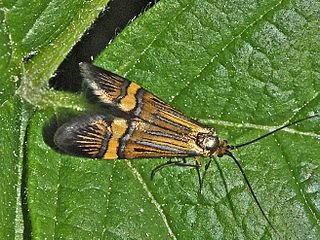
The longhorn moth or yellow-barred long-horn is a diurnal lepidopteran from the moths family Adelidae.

Mocis frugalis, the sugarcane looper, is a moth of the family Erebidae. The species was first described by Johan Christian Fabricius in 1775. It is found in several parts of the world, including India, Sri Lanka, West African countries and other Oriental regions. The adult is a fruit piercer and a major pest of crops.
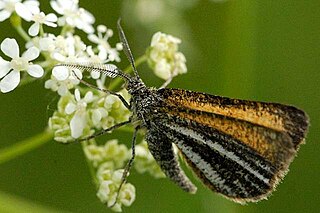
Isturgia limbaria, the frosted yellow, is a moth of the family Geometridae.

Rhodometra sacraria, the vestal, is a moth of the family Geometridae. The species was first described by Carl Linnaeus in his 1767 12th edition of Systema Naturae.

Pandemis cerasana, the barred fruit-tree tortrix, is a moth of the family Tortricidae.

Cyclophora annularia, the mocha, is a moth of the family Geometridae. The species was first described by Johan Christian Fabricius in 1775 and it can be found in Europe.
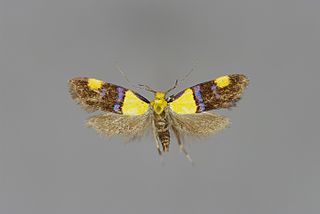
Oecophora bractella is a species of gelechioid moth. It belongs to the subfamily Oecophorinae of the concealer moth family (Oecophoridae). As the type species of its genus Oecophora, its affiliations and phylogeny determine the delimitation of that family and subfamily.

Esperia oliviella is a species of gelechioid moth.

Zygaena lonicerae, the narrow-bordered five-spot burnet, is a moth of the family Zygaenidae. The species was first described by Theodor Gottlieb von Scheven in 1777.

Pammene aurana is a moth of the family Tortricidae.

Asota ficus is a moth in the family Erebidae first described by Johan Christian Fabricius in 1775. It is found in Afghanistan, Bangladesh, China, Taiwan, India, Indonesia (Sumatra), Laos, Myanmar, Nepal, Pakistan, Sri Lanka, Thailand and northern Vietnam.
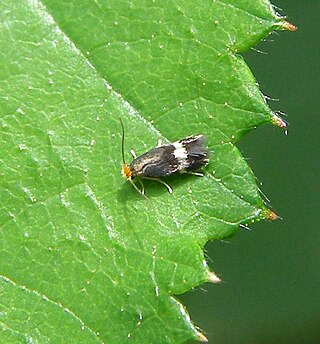
Stigmella aurella is a moth of the family Nepticulidae found in Africa, Asia and Europe. It was first described by the Danish zoologist, Johan Christian Fabricius in 1775. The larvae are leaf miners.
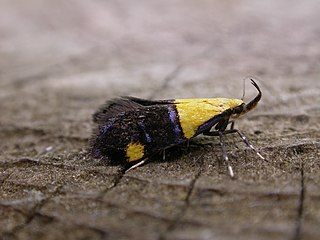
Oecophora is a genus of the concealer moth family (Oecophoridae). Among these, it belongs to subfamily Oecophorinae. It is the type genus of its subfamily and family. Thus, regardless of the uncertain phylogeny, systematics and taxonomy of its superfamily Gelechioidea, it and its closest relatives always have to be assigned to this family and subfamily as long as these are deemed valid.
Hellinsia gratiosus is a moth of the family Pterophoridae. It is found in North America

Hellinsia grandis, the coyote brush borer plume moth, is a moth of the family Pterophoridae that is found in North America, Mexico and Guatemala.
Hellinsia corvus is a moth of the family Pterophoridae first described by William Barnes and Arthur Ward Lindsey in 1921. The species is found in California, Colorado, Alberta and British Columbia.
Repnoa is a genus of moths in the family Megalopygidae. It contains only one species, Repnoa imparilis, which is found in French Guiana.

Myrmecia swalei is an Australian ant which belongs to the genus Myrmecia. This species is native to Australia and is commonly distributed in Western Australia and South Australia. It was described by Crawley in 1922.
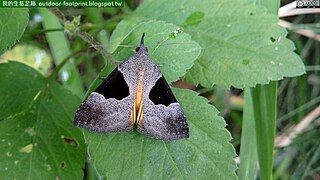
Dichromia orosia, sometimes as Dichromia sagitta, is a moth of the family Erebidae first described by Edward Meyrick in 1913. It is found in Sri Lanka and Australia. The caterpillar is a pest of Marsdenia species, Tylophora asthntatica and Tylophora indica.
